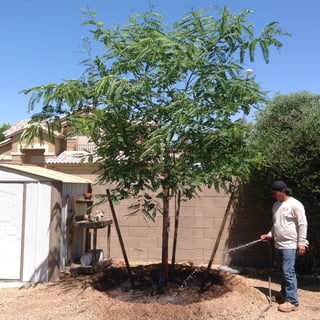How to Grow and Care for Tipu Trees
Tipu trees are a welcome addition to any landscape, especially in the desert communities where massive shade is always appreciated. After all, out here in the Southwest, the blazing sun can hammer us with the oppressive heat that can slow us down and physically drain even the toughest individuals. Luckily, there are some things we can do to alleviate the situation – plant more shade trees! And one of the best shade trees you can find anywhere is the Tipuana tipu, the superhero tree of the desert with the broad spreading canopy that provides respite from the heat! When you see these trees, you just want to run right under its canopy! Right now is the best time to plant this ridiculously fast-growing tree so that you can have the shade you want for when the desert sun is at its most oppressive. You can always buy big trees at any of our Moon Valley Nurseries, so here are some tips on how to grow and care for these large and colorful shade trees!
Tipu Trees and #FREEPLANTING!
Tipuana tipu thrives in intense heat. This is good news, since our climate offers ideal growing conditions, whether you have a home in Phoenix or Las Vegas. Giving this tree room to spread is a good idea. We like to properly plant them around a home (we specialize in this!), where they can be used to cool off those hotter rooms and possibly help you lower your utility bill too. With #freeplanting, it cannot get any easier, so be sure to discuss what you need with any of our landscape design experts. Once planted in your landscape, you will love how easy they are to grow and maintain!

Light Needs
Now that you have made the smart decision to have a Tipuana tipu tree installed in your yard, you will want to know how much sun exposure it needs. Well, these trees love full sun exposure, in fact, at least six hours of direct sun per day is ideal. The show of golden blooms in late-spring to summer is prized just as much as the shade coverage these trees produce. So, if you want the best show of flowers, let this tree revel in the sun, while you are comfortably chilling under the cooling shade canopy!
Water and Fertilization Needs
These trees do have a high drought tolerance once established and except for those sweltering days can go weeks without supplemental watering. However, when it is first planted, it does best with a deep watering. This way, it can help settle the soil around the roots and will also help you determine whether more soil should be leveled around it. One of the best ways to keep the soil moist and not overly wet is with a drip system, so if you do not already have a system set up, our professional planting team can do it.
Our Moon Dust Fertilizer has the primary nutrients of Nitrogen, Phosphorous, and Potassium, all of which are required for Tipu trees to thrive. Apply the all-purpose fertilizer and watch as this tree grows stronger and flourishes - all without having to use too much water! As great as feeding with our specialized fertilizer may be, too much promotes weak, leafy growth and fewer flowers, so use sparingly, and you will love the results!
Pruning Tips
In the Southwest, winter is one of, if not, the best time of the year to prune most landscape trees, and the Tipuana tipu is no exception. After all, who wants to be pruning during a heatwave?! This South American native that loves our western U.S. climate is prized for its upside-down vase shape because it produces all that beautiful shade. Sure, you can just let this tree grow naturally because it still looks attractive. However, by pruning the lower branches high on the trunk, you can develop the canopy to the umbrella-shaped form.
Be sure you have all the right tools before starting the project. You will need a pruning saw and a pruning lopper for moderate work and a chainsaw for the heavy work. Of course, it is a good idea to have gloves and safety glasses too. It is also good to remember that a proper cut will heal quickly. Keep in mind to remove branches that touch other limbs and to prune branches that produce little foliage.
 Use the pruning lopper on small branches and the chainsaw for the larger branches. First, for drooping branches, determine whether you want the branch to grow up, down, or sideways. Be sure to prune the branch so that it is close to the shoot or branch, in other words, where you want it to continue growing. Now, for the larger branches, you will want to fire up that chainsaw, but don’t get too crazy with it, after all, you do not want to cut too much off, or else you will lose all that shade coverage. Cut the larger branches that are more than 1.5-inches across, at least 6-to-12-inches from the trunk, and about a third of the way through the branch. You will want to cut the top of the branch about 3-inches away from the bottom cut, and you will want to do this until the branch drops.
Use the pruning lopper on small branches and the chainsaw for the larger branches. First, for drooping branches, determine whether you want the branch to grow up, down, or sideways. Be sure to prune the branch so that it is close to the shoot or branch, in other words, where you want it to continue growing. Now, for the larger branches, you will want to fire up that chainsaw, but don’t get too crazy with it, after all, you do not want to cut too much off, or else you will lose all that shade coverage. Cut the larger branches that are more than 1.5-inches across, at least 6-to-12-inches from the trunk, and about a third of the way through the branch. You will want to cut the top of the branch about 3-inches away from the bottom cut, and you will want to do this until the branch drops.
There is no need to dread pruning. It is a good way to get outdoors, burn some calories, and you get to shape as you wish! One thing is sure, big trees such as Tipuana tipu make our hot sunny days a little more bearable. Call us today to plant them now so that you are ready for the summer!
Submit a Comment